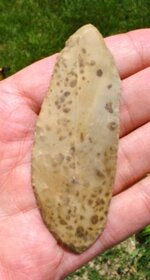uniface
Silver Member
Unfortunately, this picture isn't well enough in focus to show the quality of the edge work (completely around) on it. The sides are retouched as knife edges, steepening to high-angle scraper retouch at the two tips, forming graver spurs.
While the Dalton culture did continue the lamellar blade core technology of Clovis, I'm not aware of it ever producing anything similar to this, and am aware that this would fit easily and naturally into a frame of Clovis blades. So Clovis.
It's amazingly thin -- 6.6 mm. at its thickest point (do a quick check of 1/4 " on a ruler). 3.5 " long. The bulb of percussion is completely worked away.
Material is, I guess, Buffalo River chert. Some faint banding is visible under the patinazation. (Anybody recognise it as something else ?) The speckling is only on the top side. (Anybody have a handle on that either ?).
It might be worthwhile to note that blades like this found at any distance from the quarry/workshop sites where they were produced characteristically show edge retouching, while quarry waste reject blades (or cached blades) don't. (Was amused to see some guys on eBay fighting each other to pay somebody $100 + for a quarry waste blade from Texas not long ago. The waste blades are mostly what the Gault site has to show, because that's what they left there. So they're what gets displayed, and people take it from there). (Not that there weren't "second-choice" blades carried far afield and used -- one turned up in the Blackwater Draw area assemblage).
Found by Cecil Hewett in Allen County, Tennessee. Via John Duncan.
While the Dalton culture did continue the lamellar blade core technology of Clovis, I'm not aware of it ever producing anything similar to this, and am aware that this would fit easily and naturally into a frame of Clovis blades. So Clovis.
It's amazingly thin -- 6.6 mm. at its thickest point (do a quick check of 1/4 " on a ruler). 3.5 " long. The bulb of percussion is completely worked away.
Material is, I guess, Buffalo River chert. Some faint banding is visible under the patinazation. (Anybody recognise it as something else ?) The speckling is only on the top side. (Anybody have a handle on that either ?).
It might be worthwhile to note that blades like this found at any distance from the quarry/workshop sites where they were produced characteristically show edge retouching, while quarry waste reject blades (or cached blades) don't. (Was amused to see some guys on eBay fighting each other to pay somebody $100 + for a quarry waste blade from Texas not long ago. The waste blades are mostly what the Gault site has to show, because that's what they left there. So they're what gets displayed, and people take it from there). (Not that there weren't "second-choice" blades carried far afield and used -- one turned up in the Blackwater Draw area assemblage).
Found by Cecil Hewett in Allen County, Tennessee. Via John Duncan.
Attachments
Upvote
0






